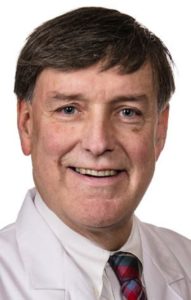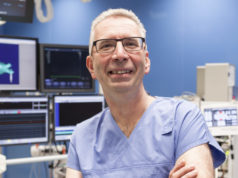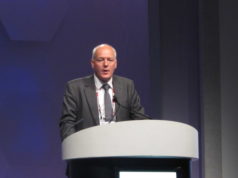
Thomas F Deering (Piedmont Heart Institute, Atlanta, USA) considers that the biggest challenge in electrophysiology (EP) is to “move from the volume to the value world of healthcare delivery” finding ways to improve lives in a “quality and cost-efficient manner”; an issue in which he is currently focusing research efforts. In this interview, he speaks about this and other research interests amongst other relevant aspects in his career and gives an overview of the highlights of this year’s Heart Rhythm Society Scientific Sessions as Programme Chair.
Why did you choose to specialise in EP?
Career choices for physicians are often directed by unanswered clinical problems, which challenge us to work in our teams to create solutions. As a young physician, when EP was in its early stages, I saw my mentors in this field characterised by a passion for learning and innovation. The evolving techniques of defibrillator and ablation therapy created an opportunity for us to move from the field of diagnostic medicine to the world of therapeutic medicine where we could identify and then rectify a problem to improve and/or prolong life. Having the chance to be involved in such an innovative specialty with smart, enthusiastic and energetic individuals was very exciting.
Who are your mentors and what influence have they had on your career?
My father established a strong foundation by emphasising hard work; demanding a commitment to excellence; ensuring the importance of being humble and taking great joy in seeing those around you succeed. I was then very fortunate to have a number of great medical mentors with very different skill sets. Dr Samuel Their, chief of Medicine during my medical school and early training years, instilled in my colleagues and me the need to always be on game and question everything, not just to be critical, but to be the best one can. My first chief of Cardiology as a medical student and young physician, Dr Larry Cohen, was the classic “art and science” of medicine mentor, who always conducted himself with dignity and respect for patients and their families, colleagues, students and all members of the medical team. Dr Mark Estes, in his classic quiet and supportive manner, made me always want to strive for excellence and compassion while understanding the importance of mentoring others as I matured in my career.
What do you consider has been the biggest development/challenge in EP?
EP has moved from that of a diagnostic-only specialty to one in which we can improve, if not always cure, clinical arrhythmic outcomes. In my opinion, the biggest challenge for our specialty, as we move from the volume to value world of healthcare delivery, is to ensure that we focus on finding ways to continue the amazing innovation of the past several decades so that we can improve lives in a quality and cost-efficient manner.
What has been the biggest disappointment—ie. something you thought would be practice-changing but was not?
I view shortcomings as “bumps in the road”, which provide us with an opportunity for improvement, rather than as disappointments or failures. To specifically address your question, I believe that atrial fibrillation (AF) ablation represents a very important clinical development. However, despite incredible advances, I think that we need to continue to strive to develop methods to differentiate more effectively those patients, who will benefit significantly from this therapy, from those who will not, while improving techniques to lower procedural risk.
You have been highly involved in research activities being participant in numerous research arrhythmia trials and also as chief of the Arrhythmia Center of Excellence of Piedmont Heart Institute; could you tell us what are the current challenges undertaking research in EP?
The biggest present challenge is one that has been around for a long time. We, as institutions and medical societies, need to continue to innovate at multiple levels (eg. develop new technologies to facilitate better clinical outcomes with lower risk; create proactive team-based clinical management processes to ensure consistent and cost-effective treatment approaches, etc.) to improve clinical advances in arrhythmic care globally.
Of the research you have seen lately, which piece do you think has had the biggest clinical impact?
I do not believe that there is a single arrhythmic research study or outcome that stands out to me as automatically or categorically representing the major advance in our field in contrast to the multiple, evolutionary and sometimes revolutionary advances. EP research is an iterative process in which the basic scientists help us define underlying mechanisms; the translational scientists help us bridge the gap from early cellular and animal research to human treatment processes and the clinical scientists build upon that foundation to demonstrate the locus for clinical benefit then, thorough the guideline process, clarify and define the role of these advances in our global arrhythmic community.
What are your current research interests?
My current interests focus on two areas. First, given my role in Piedmont Heart, I consider myself very fortunate to be surrounded by and engaged with a collaborative group of colleagues in the EP field and in our other cardiovascular divisions (eg. heart failure, structural heart, cardiothoracic surgery, general cardiology, etc.) with whom we interact. This collaborative effort enables us to combine our talents and interests to have a voice in study design and then be high-volume enrolees in a number of important pivotal trials across the entire clinical perspective.
Second, personally, I am very interested in outcomes research. As we move from the “volume to value” world we have to find ways to continue innovation in a manner that identifies effectively the patients, who can benefit most from new and evolving therapies, so that we continue to advance quality outcomes in a fiscally-sustainable manner.
What has been your most memorable case?
As an intern I had a patient with heart failure and almost incessant monomorphic ischaemic ventricular tachycardia (VT). This was in the early days of VT ablation and device therapy. The EP and cardiothoracic surgery teams collaborated to resect his left ventricular aneurysm and ablate his VT. As a result of his prolonged hospitalisation, his daughter actually got married in his cardiac care unit room because he was too sick for discharge and she was going overseas with her fiancée, who was in the military. The potential that I saw in this new field of EP hooked me while the same case drove an intern colleague and friend of mine into orthopaedics.
You have been an active member of HRS since 1987; please tell us what has been your most valuable benefit from it?
I have had the chance to work with dedicated, informed, and insightful staff, physicians, allied professionals and basic/translational science volunteer professionals, who always put patient needs and societal goals first while working together as a team. It has been very inspirational and enjoyable.
As the Scientific Sessions Programme chair and first vice president of HRS; could you tell us what the highlights of this year’s Scientific Sessions are?
This year we expanded upon our 2016 theme of “Together we are” to “Together we can”. We are excited to have Hugh Evans, who has emphasised global citizenry as a mechanism to advance humanitarian causes, as our plenary speaker. As a global society, we have a number of sessions dedicated t o communicating this message to our members and involving them in this important effort.
o communicating this message to our members and involving them in this important effort.
We continue to have great interest in the Summits and Forums, the Late-Breaking Clinical Trials, the Meet the Expert Sessions, the Live Cases, the Abstract and Poster Sessions, the Special Sessions and the many Joint Sessions.
For HRS 2017, we are aiming to bridge the past to the future. Sessions have been designed to allow pioneers in the field to share their early experiences; senior respected faculty, as mentors, to impart their wisdom on the present state of the art and new leaders to share their research and ideas on where we are going in the future. We hope that this approach will keep our meeting innovative and relevant to all attendees.
As educational opportunities continue to evolve, for HRS 2017 we have made a concerted effort to increase interaction within our sessions; to foster multidisciplinary interaction and discussion; to facilitate networking opportunities among colleagues and to increase awareness about the impact of worldwide healthcare reform for medicine in general and EP in particular.
What are the key milestones for HRS in the upcoming years?
We must create a sustainable educational platform, which extends beyond our annual meeting and, in collaboration with other organisations and societies, extends across the globe. As healthcare delivery continues to evolve, we must continue to find ways to innovate and coordinate care delivery so that we can achieve our vision of ending “death and suffering due to heart rhythm disorders.”
If you had not been a medical doctor, what would you have been?
I probably would have aimed either to be a college history or philosophy professor or pursued a career as a linguist and lived abroad to experience and learn from other people of different cultures.
Outside of medicine, what are your hobbies and interests?
I cherish my time with my fantastic wife and daughter. I have a variety of eclectic interests. To paraphrase, I am a jack of many but a master of none. I like to balance my mind and body. I read voraciously often while walking in my neighbourhood and in the woods on a variety of non-medical topics (please be assured that I do read and keep up on my medical reading) with a special interest in general philosophy, history, philosophy of science and, on the lighter side, historical novels. I love skiing and sailing but am not an expert in either. My wife and I love to travel the globe, especially Europe, and share ideas with people from different backgrounds than our own.
Fact File
Current leadership positions
2016–2017 Scientific Sessions Programme chair and first vice president of Heart Rhythm Society
2012– Chief Quality Office of Piedmont Heart Institute, Atlanta, USA
2011– Chief Centers of Excellence of Piedmont Heart Institute, Atlanta, USA
2011– Chief Arrhythmia Center of Piedmont Heart Institute, Atlanta, USA
Past and present clinical appointments
1989– Attending Physician of Piedmont Hospital, Atlanta, USA
1989–2000 Attending physician of Georgia Baptist Medical Center, Atlanta, USA
1986–1989 Attending physician of Yale New Haven Hospital, New Haven, USA
1986–1989 Attending physician of Hospital of St Raphael, New Haven, USA
Medical Education
1985–1986 Cardiac Electrophysiology and Permanent Pacing fellowship: Tufts New England Medical Center, Boston, USA
1983–1985 Cardiology fellowship: Boston University Hospital, Boston City Hospital, Boston, USA
1981–1983 Internal Medicine Residency: Yale New Haven Hospital, New Haven, USA
1980–1981 Internal Medicine Internship: Yale New Haven Hospital; New Haven, USA
1980 Medical School: Yale University, New Haven, USA, Cum Laude (Class Day Award: Top 15% of class)
Journals reviewer












